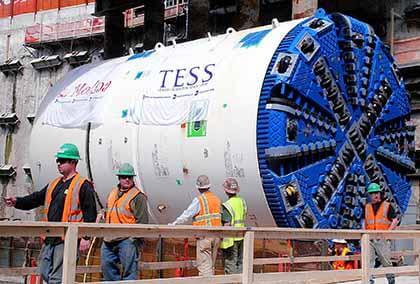By Joe Anuta
Decades after its conception, a major milestone for the country’s largest infrastructure project was reached in a construction pit in Sunnyside Friday.
City officials kicked off the last tunneling phase of the $7.3 billion East Side Access project by unveiling two new tunnel boring machines, which will help connect the Long Island Rail Road to Grand Central Station in Manhattan.
“It is truly exciting to watch the reshaping of a region,” said Jay Walder, head of the Metropolitan Transportation Authority. “It’s going to be great for the New York City economy as well as the Long Island economy.”
It has also been good for the Queens economy.
“At a time when the construction industry is struggling, take a look at the activity at this project site,” Walder said, gesturing to the bottom of a 70-foot-deep rocky pit where construction workers were coolly watching the ceremony, inspecting the spaceship-like boring machines, or in one case helping a crane operator guide a portable toilet to a safe landing from high in the air.
About 800 jobs were created in the borough as a result of the project, and many of the construction workers, called sandhogs, were hanging out near the 260-ton machines that will lead them under the Sunnyside Yards and eventually connect four new tunnels with the existing 63rd Street Tunnel.
“Anything can happen,” said Jimmy Horan, a sandhog who explained the often unpredictable nature of his job. “But we’re not blasting with dynamite, and these high-tech machines make things easier and safer.”
Horan is an electrician and spent six weeks calibrating the wiring that delivers power to the tunnel-boring machine. The machine uses 13,000 volts, roughly the equivalent of 110 toasters. That electricity powers hydraulic pistons that slowly propel the boring machine ahead at about 4 feet per hour.
Seven men operate the machine, according to Horan, with one of them essentially driving it, steering the 300-foot-long mechanical worm to ensure that the tunnel is going in precisely the right direction.
The two machines, named Tess and Molina by sixth-graders from IS 204 in Long Island City, are specially designed to cut through the soft, watery soil in Sunnyside, according to the MTA.
In fact, the entire 70-foot-deep pit was completely full of water last year, according to Billy Kelly, one of the project’s sandhogs, who produced a picture on his iPhone showing the large metal pipes overhead eerily submerged in bright blue water.
The soil is so soft that there is a danger the 22-foot-diameter hole could crumble. That is why the machines will build the tunnel as they go, according to Michael Horodniceanu, president of MTA Capital Construction, the agency managing the project.
As Tess and Molina bore through the soil, another portion of the machine lines the freshly dug hole with prefabricated sections of concrete. Workers will also lay rail as they go, Horodniceanu said.
Each day 160,000 Long Islanders arrive at Penn Station via the LIRR and must make their way back to the East Side of Manhattan, according to the MTA. The project will shave 30 to 40 minutes off their commutes as well as alleviate congestion in Penn Station, the MTA said.
The Queens side of the project will be completed in October of next year.
Reach reporter Joe Anuta by e-mail at januta@cnglocal.com or by phone at 718-260-4566.


































